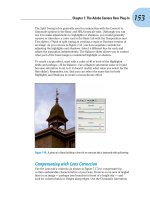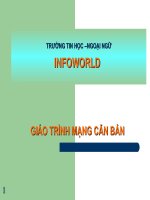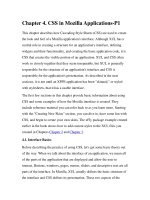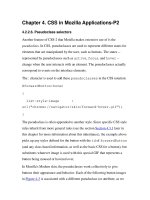Chapter 4 Digital Transmission pdf
Bạn đang xem bản rút gọn của tài liệu. Xem và tải ngay bản đầy đủ của tài liệu tại đây (1.41 MB, 71 trang )
4.1
Chapter 4
Digital Transmission
Copyright © The McGraw-Hill Companies, Inc. Permission required for reproduction or display.
4.2
4-1 DIGITAL-TO-DIGITAL CONVERSION
4-1 DIGITAL-TO-DIGITAL CONVERSION
In this section, we see how we can represent digital
In this section, we see how we can represent digital
data by using digital signals. The conversion involves
data by using digital signals. The conversion involves
three techniques:
three techniques:
line coding
line coding
,
,
block coding
block coding
, and
, and
scrambling
scrambling
. Line coding is always needed; block
. Line coding is always needed; block
coding and scrambling may or may not be needed.
coding and scrambling may or may not be needed.
Line Coding
Line Coding Schemes
Block Coding
Scrambling
Topics discussed in this section:
Topics discussed in this section:
4.3
Figure 4.1 Line coding and decoding
4.4
Figure 4.2 Signal element versus data element
4.5
A signal is carrying data in which one data element is
encoded as one signal element ( r = 1). If the bit rate is
100 kbps, what is the average value of the baud rate if c is
between 0 and 1?
Solution
We assume that the average value of c is 1/2 .
The baud rate is then
Example 4.1
4.6
Although the actual bandwidth of a
digital signal is infinite, the effective
bandwidth is finite.
Note
4.7
The maximum data rate of a channel (see Chapter 3) is
N
max
= 2 × B × log
2
L (defined by the Nyquist formula).
Does this agree with the previous formula for N
max
?
Solution
A signal with L levels actually can carry log
2
L
bits per level. If each level corresponds to one
signal element and we assume the average case (c
= 1/2), then we have
Example 4.2
4.8
Figure 4.3 Effect of lack of synchronization
4.9
In a digital transmission, the receiver clock is 0.1 percent
faster than the sender clock. How many extra bits per
second does the receiver receive if the data rate is
1 kbps? How many if the data rate is 1 Mbps?
Solution
At 1 kbps, the receiver receives 1001 bps instead
of 1000 bps.
Example 4.3
At 1 Mbps, the receiver receives 1,001,000 bps instead of
1,000,000 bps.
4.10
Figure 4.4 Line coding schemes
4.11
Figure 4.5 Unipolar NRZ scheme
4.12
Figure 4.6 Polar NRZ-L and NRZ-I schemes
4.13
In NRZ-L the level of the voltage
determines the value of the bit.
In NRZ-I the inversion
or the lack of inversion
determines the value of the bit.
Note
4.14
NRZ-L and NRZ-I both have an average
signal rate of N/2 Bd.
Note
4.15
NRZ-L and NRZ-I both have a DC
component problem.
Note
4.16
A system is using NRZ-I to transfer 10-Mbps data. What
are the average signal rate and minimum bandwidth?
Solution
The average signal rate is S = N/2 = 500 kbaud.
The minimum bandwidth for this average baud
rate is B
min
= S = 500 kHz.
Example 4.4
4.17
Figure 4.7 Polar RZ scheme
4.18
Figure 4.8 Polar biphase: Manchester and differential Manchester schemes
4.19
In Manchester and differential
Manchester encoding, the transition
at the middle of the bit is used for
synchronization.
Note
4.20
The minimum bandwidth of Manchester
and differential Manchester is 2 times
that of NRZ.
Note
4.21
In bipolar encoding, we use three levels:
positive, zero, and negative.
Note
4.22
Figure 4.9 Bipolar schemes: AMI and pseudoternary
4.23
In mBnL schemes, a pattern of m data
elements is encoded as a pattern of n
signal elements in which 2
m
≤ L
n
.
Note
4.24
Figure 4.10 Multilevel: 2B1Q scheme
4.25
Figure 4.11 Multilevel: 8B6T scheme









